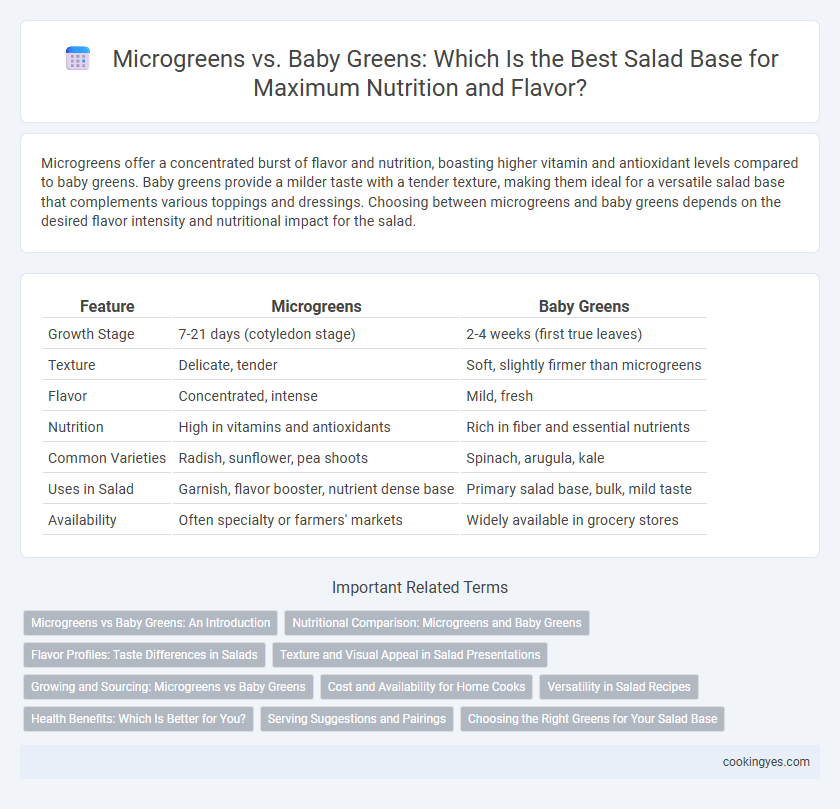Microgreens offer a concentrated burst of flavor and nutrition, boasting higher vitamin and antioxidant levels compared to baby greens. Baby greens provide a milder taste with a tender texture, making them ideal for a versatile salad base that complements various toppings and dressings. Choosing between microgreens and baby greens depends on the desired flavor intensity and nutritional impact for the salad.
Table of Comparison
| Feature | Microgreens | Baby Greens |
|---|---|---|
| Growth Stage | 7-21 days (cotyledon stage) | 2-4 weeks (first true leaves) |
| Texture | Delicate, tender | Soft, slightly firmer than microgreens |
| Flavor | Concentrated, intense | Mild, fresh |
| Nutrition | High in vitamins and antioxidants | Rich in fiber and essential nutrients |
| Common Varieties | Radish, sunflower, pea shoots | Spinach, arugula, kale |
| Uses in Salad | Garnish, flavor booster, nutrient dense base | Primary salad base, bulk, mild taste |
| Availability | Often specialty or farmers' markets | Widely available in grocery stores |
Microgreens vs Baby Greens: An Introduction
Microgreens are young vegetable greens harvested just after the first true leaves develop, offering intense flavors and concentrated nutrients compared to baby greens, which are slightly older and larger with milder taste profiles. Both microgreens and baby greens provide fresh, vibrant bases for salads, but microgreens deliver higher antioxidant levels and distinctive colors that enhance visual appeal and nutritional value. Choosing between microgreens and baby greens depends on desired texture, flavor intensity, and nutritional benefits in salad preparation.
Nutritional Comparison: Microgreens and Baby Greens
Microgreens contain higher concentrations of vitamins C, E, and K, as well as antioxidants, compared to baby greens, making them a nutrient-dense choice for salads. Baby greens offer a larger volume with more fiber and water content, supporting digestion and hydration. Both microgreens and baby greens provide unique nutritional benefits that enhance the health profile of salad bases.
Flavor Profiles: Taste Differences in Salads
Microgreens offer a concentrated burst of flavors, often more intense and diverse, ranging from peppery arugula to tangy radish, enhancing the salad's complexity. Baby greens provide a milder, sweeter taste with tender textures, making them ideal for balanced, subtle salad bases. Choosing microgreens adds boldness and vibrancy to the flavor profile, while baby greens create a smoother, more delicate palate experience.
Texture and Visual Appeal in Salad Presentations
Microgreens offer a delicate, tender texture and vibrant, intense colors that enhance visual appeal in salad presentations, making dishes look fresh and sophisticated. Baby greens provide a slightly heartier, more substantial texture with a broader variety of leaf shapes and shades, contributing to a diverse and layered appearance in salads. Combining microgreens and baby greens creates a balance of softness and crispness while delivering a visually dynamic and appetizing salad base.
Growing and Sourcing: Microgreens vs Baby Greens
Microgreens are harvested just after the first leaves develop, typically within 7-21 days, allowing for rapid growth cycles and easier indoor cultivation with minimal space. Baby greens require a longer growing period of 20-40 days and are usually grown in traditional soil or hydroponic systems, demanding more resources and space. Sourcing microgreens often involves specialized growers focusing on freshness and nutrient density, while baby greens are widely available through conventional farms and local markets, offering greater variety.
Cost and Availability for Home Cooks
Microgreens typically cost more than baby greens due to their intensive growing process and shorter harvest time, which can impact a home cook's budget. Baby greens offer greater availability in most grocery stores and markets, making them a more accessible salad base option throughout the year. Choosing baby greens often provides a cost-effective and convenient solution for fresh salad preparation at home.
Versatility in Salad Recipes
Microgreens and baby greens both offer unique versatility in salad recipes, with microgreens providing a concentrated burst of flavor and a delicate texture that enhances simple salads and gourmet dishes alike. Baby greens possess a milder taste and a heartier texture, making them ideal as a foundational base that blends well with diverse ingredients such as nuts, cheeses, and fruits. Incorporating both microgreens and baby greens into salads maximizes flavor complexity and nutritional value, catering to a wide range of culinary styles and dietary preferences.
Health Benefits: Which Is Better for You?
Microgreens pack a higher concentration of vitamins, minerals, and antioxidants per gram compared to baby greens, making them a nutrient-dense choice for salads. Baby greens offer a milder flavor and larger leaves, providing a good source of fiber and essential nutrients like vitamin K and folate. For maximum health benefits, incorporating a mix of microgreens and baby greens can enhance nutrient diversity and overall salad nutrition.
Serving Suggestions and Pairings
Microgreens offer concentrated flavors and vibrant colors, making them ideal for garnishing delicate salads or enhancing the visual appeal of plate presentations. Baby greens provide a tender texture and milder taste, perfect for mixing with robust dressings or pairing with proteins like grilled chicken, salmon, or roasted nuts. Use microgreens to add a punch to light vinaigrettes, while baby greens complement creamy dressings and hearty toppings such as goat cheese or avocado.
Choosing the Right Greens for Your Salad Base
Microgreens offer concentrated flavors and higher nutrient density, ideal for enhancing the taste and health benefits of your salad base. Baby greens provide a milder, more tender texture, making them suitable for larger salads that require a balanced flavor profile. Selecting between microgreens and baby greens depends on whether you prioritize intense flavor and nutrition or softer texture and volume in your salad.
Microgreens vs Baby greens for salad base Infographic

 cookingyes.com
cookingyes.com